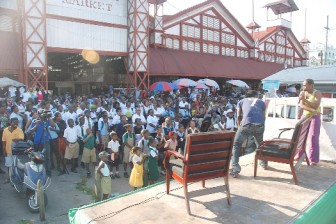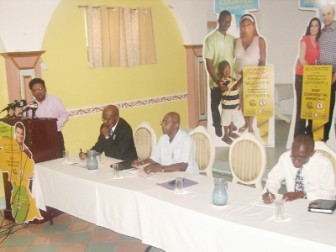Today is census day and the National Bureau of Statistics will begin a countrywide exercise to determine the size of the population resident in the country and key demographic features that will be used to inform government policy-making.
At the official launching of the Population and Housing Census 2012 yesterday, the Bureau appealed to the public to make a note of the persons in their households between midnight and 6am today, which will be used as a reference for enumerators collecting the information. Not only would all persons within Guyana’s border be counted but also all the buildings as well as the ships in port.

The six-week enumeration exercise will begin at State House today, where President Donald Ramotar’s household would be the first counted by a team led by Chief Statistician Lennox Benjamin. Afterward, the team would collect the data on Prime Minister Samuel Hinds’ household.
The census, which is budgeted at approximately US$4M or $800M, gives the demographic, economic and social conditions of a population and illustrates the conditions under which the people live.
With this year’s exercise, Guyana is fulfilling obligations, being a member of the United Nations, to complete the census in the 2010 round, which began in 2005 and ends in 2014.
The last census, in 2002, found that the country had a population of 751,223. And although it found a population increase between 1991 and 2002, the increase paled in comparison with the births during the same period, supporting conclusions that migration had been the key setback to the population’s growth rate. Benjamin has said he expects to find an increase in the size of the population from this year’s exercise.
Finance Minister Dr. Ashni Singh noted at yesterday’s launch that findings of the national census are a major policy decision making tool for both the public and private sectors. “It is easy to believe that the census only generates information that is important for government purposes and it does but importantly it generates information that is important for a multitude of other parties,” he said.
He explained that for government, policy-making is grounded in as much data that it can gather, which aids in keeping track of population and demographic trends, such as gender, age and access to social services. “It is where one sees the most rapidly-growing or developing population that one has to plan. When one sees that the population is increasing, one has to be preemptive in policy-making function to make provisions accordingly,” he added.
Turning his attention to the private sector, Singh noted that the business community has been tracking the population to determine the best place to set up shop and target new clients.

“Business leaders also actively using the census to see where the new population is growing… I know business people use what are the geographic markets they should be targeting and where and who they should be targeted,” he said.
Apart from the public and private sectors, Singh said members of the academic community also take advantage of the data generated. He was confident that the more than 3,000 enumerators would do a good job in collecting the data and that Guyanese would allow them to be counted.
“…So, Guyanese and persons living in Guyana ensure you are counted,” he urged.
The law prohibits persons from not subjecting themselves to the census, but the Bureau usually first exhausts all means to persuade people to be counted, said Benjamin.
While a major constraint in the last census was the violent crime spree ongoing at the time, Benjamin said that this time around it would be coping with the Chinese and Portuguese language barriers presented by an influx of nationals from China and Brazil. The Bureau intends to use experts from the Brazilian Institute and the Chinese Association to deal with this challenge, he informed.
Yesterday afternoon, the Bureau went on a major education sensitisation exercise at the Stabroek Market and Benjamin informed that others of its kind are being undertaken countrywide. “We are so pleased with this afternoon, especially the kids’ knowledge of the subject… the intention was get across to the ordinary man-in-the-street to put over something they can connect with, such as the content in the skit and other things and it worked,” he said.
“We want to hit home that the census is an exercise done in trust. We won’t question your answers. What the public tells us, we believe. So, we are asking their assistance to make this 2012 exercise as smooth as possible,” Benjamin added.





